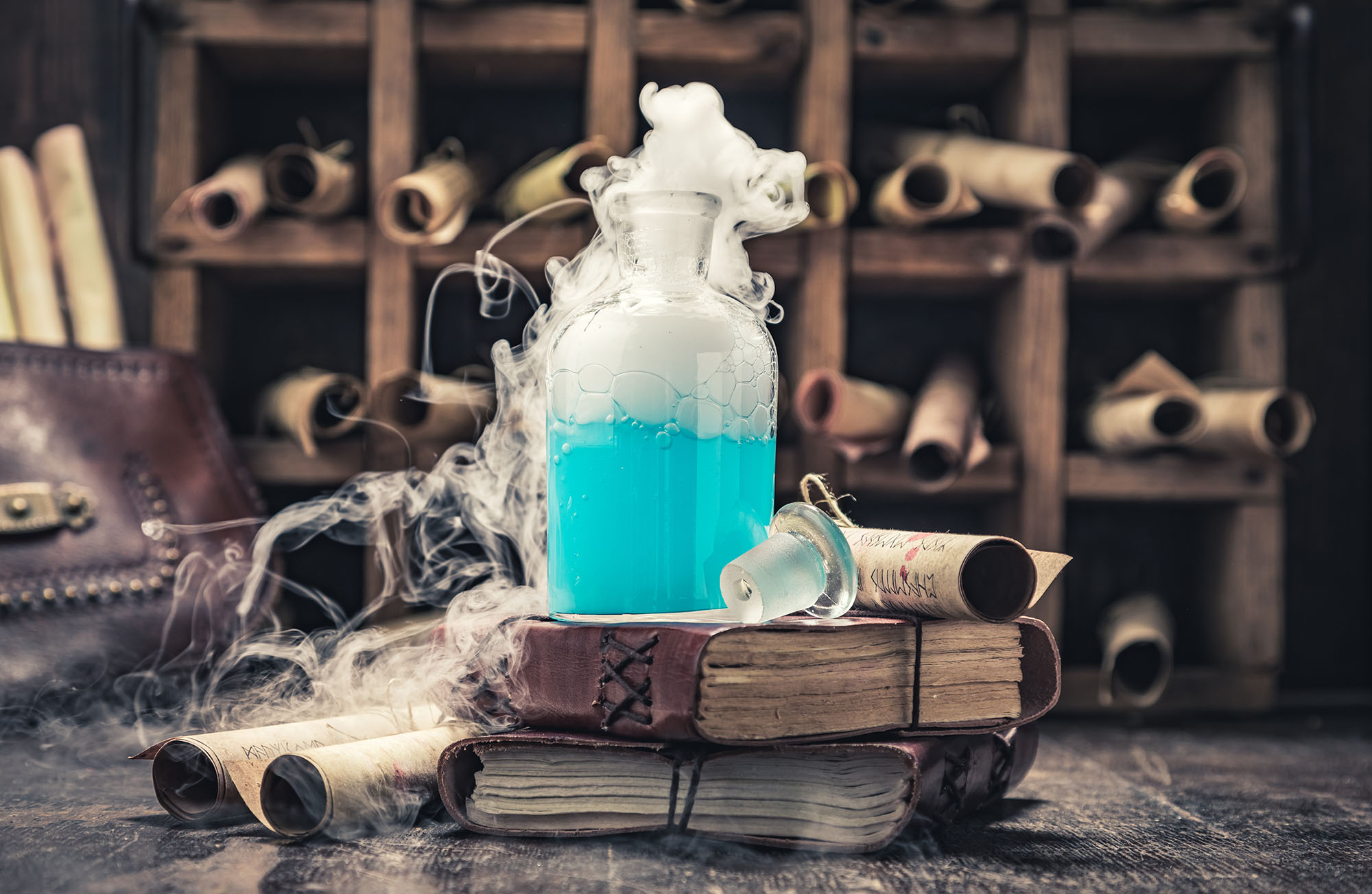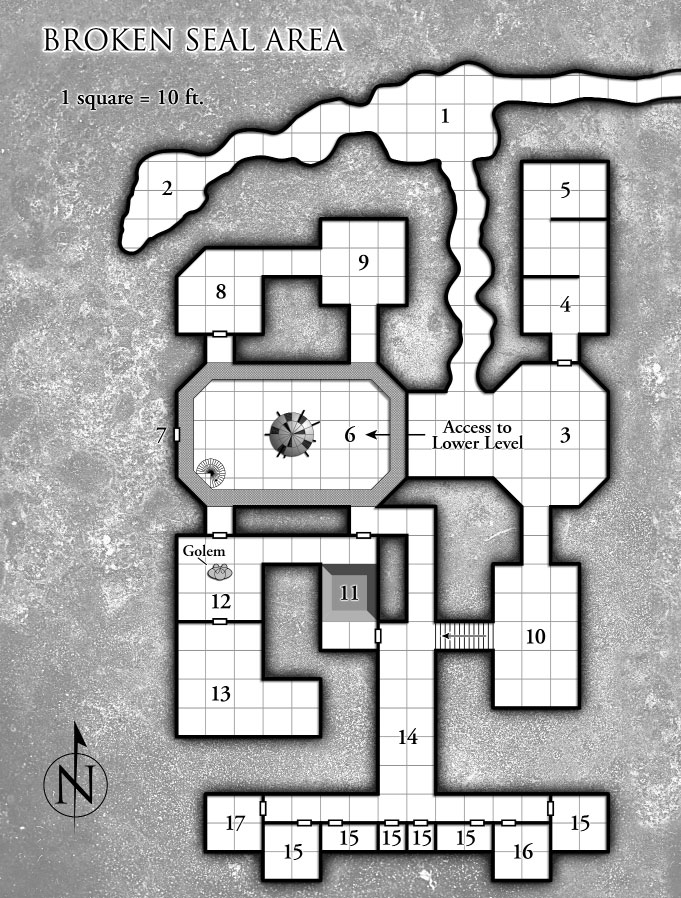DISCUSSING
In the Shadow of the Spire – Session 29C: Skirmish in the Cauldron
“Friends of that meddlesome paladin!” The minotaur turned back towards the northern passage. “Stop hiding like cowards! Attack!”
The minotaur dashed forward, quaffing a potion that caused him to suddenly blur with speed. Bunching his powerful leg muscles he leapt up onto the thick rim of the immense iron cauldron.
“They’re drinking our wealth away!” Tee cried, firing at the minotaur.
I’m a big fan of consumable magic items: Drink a potion, it’s gone. Use up the charges in a wand, it’s done. 5th Edition D&D turning a bunch of consumable items into permanent items via recharging charges is somewhat inexplicable to me.
See, the great thing about a consumable item is that you can give it to the PCs with an almost completely clear conscience: If you give them a permanent item and it screws up game balance, then you’ve got a permanent problem. Miscalculate and give them a consumable item that’s more powerful than you thought it would be? It’s a self-correcting problem.
In fact, you can do this deliberately: Here’s an incredibly powerful item far beyond anything you’d normally be able to get your hands on. It can literally change the course of the entire campaign… but it’s only got one charge. Use it wisely.
(You’ll see some of these uber-powerful consumables show up in future sessions.)
Monte Cook’s Numenera is a game that leans in hard on consumables: A billion years in the future, cyphers are the enigmatic remnants of the mega-civilizations which lie between our own time and the neo-Renaissance of that far-flung epoch. All cyphers are consumables and the vast majority of them are one-use items. Furthermore, due to strange interactions between cyphers it’s very dangerous to carry more than a few of them, so you’re heavily motivated to use the stuff you’ve got so that you can pick up more.
It’s a fantastic mixture of lore and mechanic: The cyphers are constantly injecting a wild mixture of new abilities, keeping the game fresh and exciting.
Even when treasure hordes get larded with consumables, though, I too often see GMs ignore them during encounters. As you can see here, that’s not my philosophy: My bad guys will use their personal stockpile of consumables to best effect, which has the dual effect of (a) injecting them with unexpected abilities and (b) enraging players who are being blasted at the expense of their own reward!
But it’s a good rage: It motivates players to think strategically and strike hard to preserve “their” loot. It’s a very diegetic way of rewarding better performance with bigger rewards.
When I’ve set up an encounter, I actually enjoy rolling on some random magic item tables to generate one or two or a grab bag of consumables. It’s a great way to shake up an encounter and make it a unique experience: An elite squad of goblin commandos who suck down potions of giant strength are very different from the ones with potions of gaseous form or invisibility.
TANGENT: THEATER OF OPERATION
In Running the Campaign: Dungeon as Theater of Operations I talked about how you should stop thinking of an encounter as “belonging” to a specific room and instead start thinking of the dungeon as a holistic environment.
I mentioned that when you, as the GM, think about the dungeon this way and run encounters this way, that the players will also learn to think that way. And you can really see that in this session:
- The lamia flees from Area 11 to Area 10.
- NPC reinforcements arrive from Area 1.
- Agnarr is forced to flee down towards Area 17.
- Ranthir blocks the hallway between Area 10 and Area 17 to cut off the reinforcements.
- Later, Ranthir races up through Area 6 and into Area 3 to try to cut off the goblins’ escape.
- Missing some of them, he chases them through Area 1 and down the long hallway, while Tee also fetches up in Area 3 and takes out some of the other goblins.
This is an encounter that could have stayed locked to Area 11. Instead, it ranged across almost the entire dungeon level.
Campaign Journal: Session 30A – Running the Campaign: Cut on the Cliffhanger
In the Shadow of the Spire: Index














Following on from that tangent – how do you deal with blowing out the scope of the combat when you involve all these concurrent story elements? Do you remain in initiative order, cut in and out, or handle it totally differently?
One problem I’ve run into with the theater of operations thing, and I’d be interested to know how and if you’ve dealt with it, is convincing the players that it’s possible. I’ll have reinforcements arrive from another room, and they think it was a pre-scripted sequence. They choose to retreat from an encounter and they think it was something I planned to make them lose (which is hilarious since they almost exclusively retreat from encounters that I planned to be easy after die rolls go horribly wrong). Even in cases where the dungeon is small enough for me to draw out the entire thing out on the map in front of them, they still treat the encounters as locked into the rooms they’re found in and treat leaving the room not as the encounter widening or trying to move to a more favorable terrain, but as tantamount to defeat.
I’ve tried outright telling them that’s not how it works, that they’re allowed to think about the dungeon space more broadly, but nothing seems to penetrate. It’s like they’ve been trained to think in only one way and can’t break out of that conditioning.
@Wesley I would say there is no easy answer that will get them to understand immediately, but there are steps to reverse the programming.
1. Be explicit on the battlefield. Instead of more monsters just appearing cause they heard from the room next door, show enemies running to various alarms within the dungeon. The players have to prevent going off within 2 rounds.
2. Use dynamic battlefields to connect the “rooms” visually – for instance maybe there are enemies on front of you and on the cliffs high above. With the right warning, maybe a fire, the group above could be called into battle. That way the can see separate battle areas as more fluid.
3. The last piece Id say is turn the tables. Have allies call them for help using the same techniques you’d use for monsters. The more players experience each room isn’t an island, the more they’ll accept dynamic encounters
I have a pretty hard time getting players to use consumables, given that most RPG systems allow the players to sell them.
“Do we *really* need to use this alchemist’s fire that we just looted, or can we save it to sell in town when we get back? If we use it, that’s lighting money on fire; money that can be spent on powerful permanent items.”
One thing I really like about powerful consumables (or similar effects such as one-use favours) is that they allow for a real element of sacrifice and commitment. See, one of the best ways to define what is important to a character is to look at what they’re willing to sacrifice to get or to protect. Having a character blow the horn to call for the aid of the Wild Hunt or drink the *potion of +4 to everything* signals that whatever they’re fighting for is important to them, that this and not anything else is worth spending those resources.
Beau @4, that’s a big reason I hate letting PCs just buy magic items. (The other is that if you can buy it for money, it really feels a lot less magical.)
Personally, I don’t care if the DMG has prices listed for magic items, there are no “magic shops”. *Maybe* you can find an enchanter who’ll put a +1 on your blade for you, just because there’s usually a point in the campaign where not having a magic weapon can be crippling.
“In fact, you can do this deliberately: Here’s an incredibly powerful item far beyond anything you’d normally be able to get your hands on. It can literally change the course of the entire campaign… but it’s only got one charge. Use it wisely.”
One variant on this that I am very fond of is the “get out of jail free card”, some kind of one-shot item that the players can use to escape bad situations or save themselves from a bad end. For example, imagine a one-shot teleport item (in a campaign where the players are too low-level to cast teleport spells) that when used will teleport the entire party back to a safe base. Now if the party gets a streak of bad rolls or does something stupid, they can escape to safety… but they only get one escape, so they still have to be careful.
Or imagine you’re running a zombie plague scenario for level 2-3 players (so a few levels too low to cast *remove disease*), and near the beginning of the scenario you let the players find a cache of six *remove disease* potions. Now the players have a bit of a safety net so that one bite isn’t an automatic death, but they only have six of the potions so zombie bites are still a very serious threat.